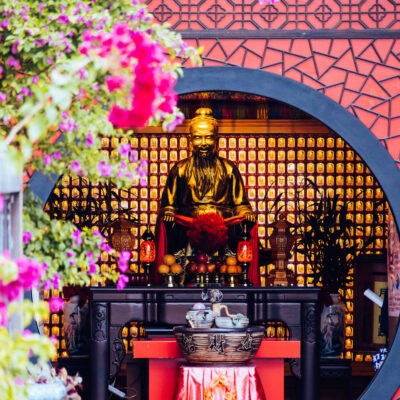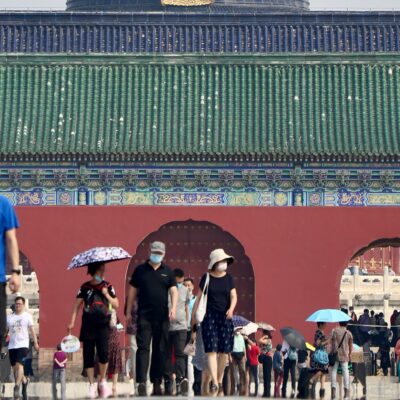North Korea was arguably the biggest story in Northeast Asia in 2017—2018, and the world continued to watch closely as the summit diplomacy between Kim Jong-un and US President Donald Trump fizzled in 2019. Pyongyang has been less prominent since then, with most of the region’s political oxygen consumed by pandemic-induced strife and China’s aggressiveness on several fronts. Now widely accepted as having a nuclear weapons capability, North Korea continues to negatively impact international security and cooperation in several ways. Importantly, however, what the outside world commonly terms ‘provocative’ behaviour by the Kim regime has not appreciably increased since it went nuclear.
North Korea as regional irritant
To be sure, the Democratic People’s Republic of Korea (DPRK) continues to make life uncomfortable for its neighbours.
Pyongyang maintains a bellicose posture toward Seoul and the United States. Its warlike rhetoric would be shocking if the outside world was not inured to it due to decades of repetition. This reflects a seemingly intractable spiral: Pyongyang opposes US-South Korea military training exercises, calling them evidence of planned aggression against North Korea, and tries to stop them by threatening war. These threats renew the perception among the US and South Korean governments that Pyongyang is dangerous, reinforcing their commitment to maintain military readiness against a possible North Korean attack. Japan, as well, sees the DPRK as an extraordinary threat because of its permanent anti-Japan ethos and its deployment of missiles that can target Japan. Japanese Prime Minister Fumio Kishida said in October 2021 that the DPRK’s missile and nuclear weapons development is driving Tokyo to consider acquiring a capability to strike missile launch sites in northern DPRK, a step Beijing strongly opposes because of its ramifications for China’s defence.
The North Korean government continues to expand and diversify its already worrisome weapons systems. Late last year, it tested a submarine-launched ballistic missile capability, a long-range cruise missile, and what the regime claimed was a hypersonic glide vehicle. These weapons were previously in the exclusive domain of the major powers. One might argue this has the positive effect of deterring another Korean War. Aside from North Korean propaganda, however, there is no indication that any country is hankering to attack the DPRK. Washington could have destroyed the regime and even the country with nuclear weapons during the 53 years between the end of the Korean War and the DPRK’s first nuclear weapons test but did not. Rather, US policy is to contain the DPRK. For their part, South Koreans are in no hurry to reunify the Peninsula.
US-DPRK relations remain poor and stagnant. The immediate US goal is getting Pyongyang to permanently dismantle its nuclear weapons and ballistic missile programs. More broadly, Americans dislike oppressive authoritarian governments and aspire to replace them with politically and economically liberal regimes. The Kim regime’s governance model, however, is fundamentally authoritarian and oppressive, and uncomfortable with anything else. Furthermore, the Trump Administration’s unsuccessful negotiations with Kim strengthened the consensus in the US policy-making community that Pyongyang intends to keep its nuclear weapons and missiles. Pyongyang continues to demand sanctions relief and arms control talks that implicitly acknowledge North Korea as a permanent nuclear weapons state. The US government under President Joe Biden demands significant movement toward denuclearisation as the price of any sanctions relief, refuses to officially recognise the DPRK as a nuclear weapons state, and appears resigned to a policy of malign neglect of North Korea while focusing on opposing China and firming up relationships with allies. Thus, each side is essentially waiting to be accommodated by the other: US Secretary of State Antony Blinken saying ‘it is up to North Korea to decide whether it wants to engage or not,’ while DPRK officials call on the USA to stop military exercises with South Korea and ‘give up . . . the deployment of all kinds of strategic weapons which are levelled at the DPRK.’
The issue of North Korea continues to aggravate relations between the United States and China. American politicians have long said Beijing can and should use its influence to get the DPRK to denuclearise. Chinese officials respond that they have little control over Pyongyang, and that pushing too hard will result in the North Koreans angrily disregarding all Chinese input. Confusion results from a failure to understand that while Beijing says it supports DPRK denuclearisation, China’s highest priority is avoiding a collapse of the Kim regime. Beijing would never exert such pressure on Pyongyang as might endanger the DPRK’s political stability. Thus US observers mistakenly think they and China are committed to the same objective, and are often frustrated when China’s performance fails to meet their expectations. Some Americans believe Beijing exploits the crisis by using a nuclear-armed DPRK as strategic leverage against the United States. Chinese analysts have argued that a belligerent North Korea ‘pins down’ US forces that could otherwise fight in a Taiwan contingency. Pyongyang at least occasionally acts as a Chinese proxy to oppose US policy.
Beijing commonly links various issues in US-China relations. In September 2021, Chinese Minister of Foreign Affairs Wang Yi said Chinese cooperation on limiting climate change was contingent on the USA making political concessions such as ‘stop viewing China as a threat and a rival’ and ‘cease containing and suppressing China all over the world.’ Hence the US fear that China sees North Korea as a bargaining chip, perhaps in discussions over US arms sales to Taiwan.
Pyongyang continues to exploit South Korean President Moon Jae-in’s near-desperate desire for a rapprochement and the beginning of a bilateral economic partnership before his term ends in May 2022. North Korean officials have alternatively disparaged the Moon government and offered conciliatory hints. That has been enough for Moon to (unsuccessfully) press Washington to drop economic sanctions against the DPRK as a way of encouraging North Korean denuclearisation, which is roughly the reverse of the US approach.
The Kim regime keeps the northern half of the Korean Peninsula artificially disintegrated from the regional economy. North Korea remains the Asian economic anti-tiger—a state whose economy stalled in the 1970s and continued to sputter thereafter, surrounded by countries famous for their spectacular recent economic development. The annual per capita GDP of North Koreans is US$1,700, compared to US$9,800 for China, US$31,000 for South Korea, and US$39,000 for Japan. If the DPRK government was not so fearful of outside influence, market forces and the accumulation of private wealth by its own citizens, considerable economic cooperation would be possible even if North Korea remained a separate country from the Republic of Korea (ROK). The two Koreas have high economic complementarity. The South is better suited for agricultural production, while the more mountainous North is rich in minerals. The South has capital and managerial expertise, while the North could supply cheap labour. The Kim regime’s control of northern Korea is also an obstacle to region-wide projects such as a Russia-to-South Korea natural gas pipeline and a Northeast Asia electrical supergrid. Currently much potential for mutual multilateral benefit goes unrealised.
In the realm of non-traditional security threats, the persistence of the DPRK contributes to global crime and perpetuates massive humanitarian and human rights problems. North Korea troubles the international community with a variety of illicit activities, including counterfeiting, cybercrime, drug trafficking and weapons smuggling. Structurally-inherent mismanagement by a regime that imposes strong state control over the economy, tolerates widespread corruption in some forms, and politicises the quality and availability of food and shelter has contributed to chronic undernutrition and occasional bouts of starvation. The regime’s indulgence in politically-motivated persecution, imprisonment and capital punishment, often including the family members of accused offenders, is legendary. In theory, the DPRK would seem to deserve at least serious consideration of eligibility for foreign intervention on humanitarian grounds under the United Nations’ ‘responsibility to protect’ doctrine. But that, of course, is not a practical option given the antipathy toward triggering a war with North Korea.
Ambiguous impacts
Gaining a credible nuclear weapons capability led to an improvement in the DPRK’s relations with China in two ways. First, the moment of China’s maximum disapproval of North Korean has passed. Beijing has always criticised US and UN economic sanctions on North Korea, but in 2017 China did a reasonable job of enforcing the sanctions—likely out of fear the USA and the DPRK were drifting toward war. Since Kim declared his nuclear mission accomplished, however, China has returned to merely paying lip service to enforcement. Second, nuclear weapons gave the DPRK increased international leverage that forced Beijing to take the Kim regime more seriously. China’s President Xi Jinping avoided Kim for five years, but then met with him five times within 15 months starting in early 2018. A more cordial China-DPRK relationship might increase the possibility that Pyongyang will take Beijing’s advice. Some of that Chinese advice is constructive, such as limiting tensions with the USA and the ROK and implementing economic reforms along the lines of post-Mao China, which would likely raise living standards for many North Koreans.
The Kim regime’s continued commitment to its own survival at all costs remains an obstacle to Korean reunification. But while this is tragic from the standpoint of Korean nationalism, the division of the Peninsula into separate states has the unstated approval of Russia, China and Japan. China and Russia prefer division to a stronger, united Korea that would likely be pro-US. Beijing also worries about Korean irredentism toward areas near the Sino-DPRK border that the PRC currently controls. Japanese fear the prospect of Koreans in both North and South being able to collectively focus their efforts on their common desire for revenge against Japan for its former colonisation of Korea.
The Kim regime’s hostility toward Seoul continues to provide the primary justification for the US-ROK alliance, with the protection of South Korea against Chinese domination a secondary, less openly-discussed rationale. The value of this alliance depends on one’s point of view. To the US government, the alliance is ‘the linchpin of peace, security, and prosperity for Northeast Asia, a free and open Indo-Pacific region, and across the world.’ PRC officials and commentators, however, argue that the presence of US military forces on the Korean Peninsula is more likely to cause war than peace in the region, and that Washington tries to use its strategic influence over Seoul to push South Korea into joining an anti-China coalition. Although most of the South Korean public supports the alliance, some critics argue that the presence of US troops was an obstacle to the country’s democratisation. Some analysts argue that the ROK is capable of defending itself from a DPRK attack, and that withdrawing US troops from South Korea would reduce the chances of another Korean War by making Pyongyang feel less threatened. Furthermore, a US-allied South Korea is vulnerable to its interests being trodden over in times of US-China tensions. This occurred in 2016—2017, when Seoul deployed a US-made anti-missile system at the behest of Washington, leading to economic punishment by the Chinese government that cost the ROK billions.
Exaggerated dangers
As poor as Pyongyang’s domestic stewardship and international citizenship have been, the situation in this new era is considerably better than many analysts predicted.
By the beginning of 2022, the prognostications of danger posed to the region by a nuclear-armed North Korea appear to have been exaggerated.
A crisis over Pyongyang’s desire to acquire nuclear weapons broke out in the early 1990s, subsided temporarily with the 1994 Agreed Framework, and flared again starting in 2003. Tensions peaked in 2017. Having already carried out several progressively-larger nuclear test explosions, the North Koreans launched missile prototypes that demonstrated to outside observers that Pyongyang was getting close to fielding a vehicle that could potentially carry a nuclear warhead to the US homeland. The then-President Trump vowed to prevent the DPRK from getting this capability and threatened to ‘totally destroy’ the country if necessary.
The US military high command reportedly seriously considered a limited military strike to dissuade the Kim regime from continuing work on its long-range missile program. Kim, however, called Trump’s bluff. On Nov. 28, 2017, the DPRK test-fired a missile that appeared capable of reaching anywhere in the continental United States. DPRK media reported Kim as saying this launch ‘completed the state nuclear force.’
In his 2018 New Year address, Kim reiterated that ‘We achieved the goal of completing our state nuclear force in 2017,’ and that thereafter he would focus on ‘mass-production’ and ‘deployment’ of nuclear weapons and ballistic missiles. Senior US government officials said the DPRK had attained a theoretical nuclear strike capability against the US homeland.
The DPRK’s acquisition of a credible nuclear weapons capability led to a significant reduction in tensions. In the immediate aftermath of Kim’s announcements there was an artificial and temporary improvement in DPRK-US relations because of Kim’s peace offensive and claimed willingness to bargain away his nuclear weapons program. This lasted until the second Trump-Kim summit in Hanoi in February 2019, after which it became clear that Kim’s intention was to trade non-essential pieces of his military infrastructure for major sanctions relief, an approach Washington rejected. More importantly, post-Hanoi bilateral tensions remained much lower than during 2017. The reason is that the period immediately before the DPRK attained a credible nuclear weapons capability (bomb and delivery system) was extraordinarily dangerous. Washington understood that neither economic sanctions nor US pressure on Beijing would halt Pyongyang’s development of a nuclear Inter Continental Ballistic Missile. The situation forced the US government to choose between military intervention and accepting a grave and permanent strategic setback—one that Trump had promised to prevent. That dangerous moment passed as Washington confronted a familiar problem: a military attack on the DPRK would run the unacceptable risk of causing catastrophic North Korean retaliation against Seoul. South Korea even asserted its right to veto a contemplated US attack.
The fact that Kim pressed forward with his nuclear ICBM program in 2017 despite Trump’s threats is highly significant. Despite countless statements from North Korean officials over many years that the DPRK felt harassed by a ‘hostile’ and purportedly aggressive USA bent on war, and despite Pyongyang repeatedly threatening to bombard the USA with nuclear weapons once they were available, Kim evidently felt confident that Washington would not strike the DPRK even when the rationale for a US pre-emptive attack was at its highest point since the end of the Korean War.
The prospect of the DPRK acquiring nuclear bombs generated anxiety that cash-poor Pyongyang would sell nuclear weapons technology to any wealthy buyer, including difficult-to-deter non-state actors. To be sure, North Korea’s track record would seem to justify concern. Pyongyang reportedly provided Syria with nuclear reactor technology between 2002 and 2007 and sold uranium to Libya in 2001. Several reports have accused Pyongyang of nuclear cooperation with Iran since the early 1990s, although the US Congressional Research Service concluded in 2016, ‘there is no evidence that Iran and North Korea have engaged in nuclear-related trade or cooperation with each other.’
Nevertheless, the nuclear-armed DPRK has not become the dreaded ‘nuclear bazaar.’ The likelihood of state governments giving nuclear weapons to terrorist groups is generally overblown. Kim might also be refraining from proliferating to other governments to substantiate his claim that North Korea is a ‘responsible nuclear weapons state,’ part of his campaign to get Washington to officially recognize the DPRK as a permanent member of the nuclear club.
Another worry that has not materialised is Pyongyang employing ‘nuclear blackmail’—i.e., making demands of foreign governments paired with a threat to launch a nuclear attack if the demands are unmet. A specific envisaged danger was the North Korean government pressuring Seoul to agree to new political arrangements that would give Pyongyang control over the entire Peninsula, and Seoul complying out of fear of the DPRK’s nuclear weapons. But Pyongyang has made no such demands. Somewhat ironically, since it became a de facto nuclear power, the DPRK government’s threats to use military force against South Korea over issues such as propaganda leaflets and military exercises have usually been vague and generic, in contrast to the pre-nuclear era when Pyongyang used vividly nuclear-like imagery such as turning ‘the whole of South Korea . . . into a sea of fire.’
Nor has Pyongyang’s acquisition of the bomb caused a ‘nuclear domino effect.’ South Korea has the technological mastery to field its own nuclear weapons, which would be an understandable reaction to proliferation by its main rival and adversary. This would in turn create pressure on Japan to respond in kind, lest it find itself under unanswered nuclear threat from three unfriendly neighbours. But while both countries have thought about going nuclear, neither of these scenarios has occurred.
Although Washington, Seoul and Tokyo oppose the expansion of systems that could deliver DPRK nuclear attacks against foreign adversaries, this expansion will not seriously affect regional stability. Submarine-launched ballistic missiles and hypersonic glide vehicles might increase Pyongyang’s confidence that it has a nuclear second-strike capability (i.e., it can carry out a punishing counterattack after absorbing a nuclear bombardment by an enemy), but no amount of these weapons will give Kim a first-strike capability (negating America’s second-strike capability).
Finally, nuclear weapons have not resulted in an emboldened Pyongyang carrying out increased conventional military attacks against South Korea. After the large number of South Koreans killed by the artillery strikes on Yeonpyong Island and the sinking of the ROK warship Cheonan in 2010, Seoul announced that thereafter it would respond with disproportionate military force to North Korean attacks. Since then, fatal DPRK attacks on South Koreans have been limited to the murder at sea of an ROK maritime police official, an incident for which Kim Jong-un apologised. The restraint apparently induced by Seoul’s retaliation policy has continued into the DPRK’s nuclear era.
Diminished leverage
Pyongyang had unusual international leverage as it got close to developing a credible nuclear weapons capability. That window, however, has closed, and the region has largely moved on. North Korea has developed nuclear weapons at great cost but cannot use them without inviting state and regime destruction. For this massive investment of resources that could otherwise have improved basic needs such as food production, Kim gained only a bit of prestige and unnecessary deterrence against foes that have no interest in invading the DPRK. Seoul under the liberal government led by Moon Jae-in was primed to befriend the Kim regime, but this was independent of the DPRK going nuclear. Washington is content to rely on deterrence and has neither lifted the sanctions nor officially recognised the DPRK as a nuclear weapons state.
Pyongyang remains a regional irritant and international outlaw government. Yet the DPRK has not become more aggressive since becoming a de facto nuclear weapons state. Its major strategic impacts on Northeast Asia are preventing the emergence of a united and stronger Korea, stoking military tensions, and justifying the US-ROK alliance. The situation is reminiscent of the time prior to the DPRK’s first nuclear test explosion. Like then, Pyongyang pursues its agenda with the ROK and the USA, occasionally getting economic handouts but failing to expel US forces from the Peninsula. That North Korea acquiring nuclear weapons has thus far proved not to be a ‘game changer’ is remarkable given the jitters of 2017.
Image: North Korea’s leader Kim_Jong-un. Credit: Prachatai/Flickr.




